Winter 2009
 |
||
"We’re an advocate for an understanding of science, and a place where the public can go to get information to help make decisions that impact their everyday lives."Ron Baillie, the Henry Buhl, Jr., Co-Director of Carnegie Science Center |
Putting the Popular In Science
For 70 years, Buhl Planetarium and its modern-day successor, Carnegie Science Center, have been Pittsburgh’s favorite places to learn about, and maybe even fall in love with, everyday science. By Reid R. Frazier In the fall of 1939, crowds of Pittsburghers flocked to something new and majestic on the city’s North Side. Were it to happen today, you might call it “cool.”The attraction: a brand new building with modernist friezes on its façade, marble hallways inside, and exhibits showing what one chronicler called “the amazing, almost miraculously swift, onward advance of scientific progress.” 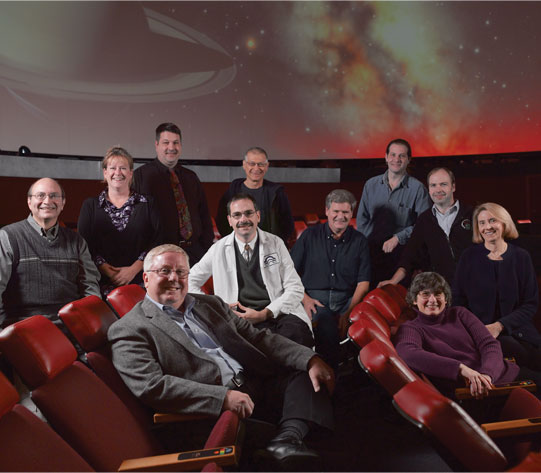 Ron Baillie, the Henry Buhl, Jr., Co-Director of Carnegie Science Center, front, with current Science Center staff who also worked at Buhl Planetarium (left to right): Dan Malerbo, Kim Bonenberger, James Hughes, Dennis Bateman, Jim Dhayer, Jim Twigger, Chris Madden, Rich Kwiatkowski, Linda Kent, and Carol Schoemer. Not pictured: Tom Flaherty, Shirley Hughes, and Jean Philpott. Photo: Ric Evans
The opening of Buhl Planetarium and Institute of Popular Science began an era, now in its seventh decade, of informal science in Pittsburgh. Since then, the Buhl and its modern-day successor, Carnegie Science Center, have inspired, awed, and informed generations of Pittsburghers. From the mysteries of deep space to the wonders of the human anatomy, they’ve helped us gain a better understanding of the complex forces that shape our lives. And, of course, they’ve infused their special brand of teaching with a lot of fun along the way. 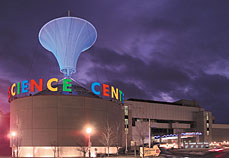 Now, as then, the science center experience is an important way to understand the modern world, says Ron Baillie, the Henry Buhl, Jr., Co-Director of Carnegie Science Center. “We’re constantly bombarded with issues that relate to technology and science,” says Baillie, who started his career as education coordinator at the Buhl in 1982. “If we don’t understand the issues, then we’re subject to those who want to twist our arms in whatever ways they want to. That’s the role that informal science tries to play. We’re an advocate for an understanding of science, and a place where the public can go to get information to help make decisions that impact their everyday lives.” Now, as then, the science center experience is an important way to understand the modern world, says Ron Baillie, the Henry Buhl, Jr., Co-Director of Carnegie Science Center. “We’re constantly bombarded with issues that relate to technology and science,” says Baillie, who started his career as education coordinator at the Buhl in 1982. “If we don’t understand the issues, then we’re subject to those who want to twist our arms in whatever ways they want to. That’s the role that informal science tries to play. We’re an advocate for an understanding of science, and a place where the public can go to get information to help make decisions that impact their everyday lives.”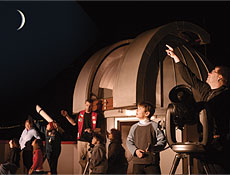 Over the past 20 years, Carnegie Science Center has redefined and enlarged its own role as a purveyor of informal science. It still adheres to its longtime motto, “an amusement park for the mind,” plying the latest hi-def, hi-tech wizardry to inspire the next generation of scientific explorers. But its impact is broader than ever—reaching nearly 600,000 people each year onsite and an additional 180,000 children through camps, classes, and outreach programs. Over the past 20 years, Carnegie Science Center has redefined and enlarged its own role as a purveyor of informal science. It still adheres to its longtime motto, “an amusement park for the mind,” plying the latest hi-def, hi-tech wizardry to inspire the next generation of scientific explorers. But its impact is broader than ever—reaching nearly 600,000 people each year onsite and an additional 180,000 children through camps, classes, and outreach programs.The groundwork for all this good work was laid more than 70 years ago, when a very different kind of museum opened its doors. Democratizing science“For too long,” reads one of the Buhl’s early annual reports, “new scientific discoveries were the prized and secret possessions of scientists who regarded popularization as vulgarization.”Pittsburgh’s Buhl Planetarium—the fifth ever built in the United States and the first institution of its kind to include the words “popular science” in its title—would reverse this old way of thinking. The Buhl joined like-minded institutions of the day in Philadelphia, Chicago, and New York that were letting the secrets out by introducing the latest technological breakthroughs to the public. “These new centers—and the Buhl was one of them—wanted you to explore the world around you,” says Bonnie VanDorn, executive director of the Association for Science-Technology Centers. “They felt science was for the common people, not just the experts. In a way, they democratized science.” Buhl Planetarium was the legacy of merchant and philanthropist Henry Buhl, Jr., co-founder with business partner and brother-in-law, Russell Boggs, of the upscale Boggs and Buhl Department Store in old Allegheny City (now part of Pittsburgh’s North Side). Built with a $1 million gift from the Buhl Foundation, it opened in October 1939. 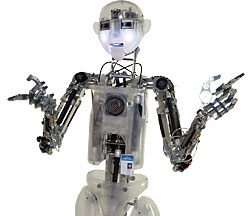 By joining a planetarium with a science museum, the Buhl bridged astronomy with other terrestrial sciences. “There were several planetariums before the Buhl, but not places that approached science in as broad a way as the Buhl did,” Baillie notes. By joining a planetarium with a science museum, the Buhl bridged astronomy with other terrestrial sciences. “There were several planetariums before the Buhl, but not places that approached science in as broad a way as the Buhl did,” Baillie notes. Special display cases connected to a central “record room” allowed visitors to press a button to hear recorded presentations on the items in the case. What those visitors didn’t know was that an attendant in the record room was actually playing a phonograph every time the button sounded a buzzer. These were the first interactive displays in the country. As new technology evolved, such as magnetic tape, the Buhl incorporated it into its exhibits. In the planetarium’s lobby swung a Foucault pendulum, a device that demonstrated Earth’s rotation on its axis. On the rooftop, a Siderostat telescope allowed viewers to follow a star or planet across the sky. “The Buhl was the only place in Pittsburgh where you could go and actually see science,” says Charles J. “Chuck” Vukotich, Jr., a Carnegie Science Center board member. “For people of my generation, it was the place you went and got inspired about science.” The magic lanternFrom day one, the planetarium’s central attraction was its “Theater of the Stars,” featuring the wondrous Zeiss Model II Planetarium Star Projector. An elevator lifted the praying-mantis-like Zeiss out of the floor of the planetarium, then the projector would light up a 65-foot domed ceiling and treat visitors to various depictions of the night sky.“Anyone who was born in Pittsburgh in the 1940s, ‘50s, or ‘60s probably has a fond memory of the Zeiss coming out of the floor at the planetarium,” says Fred Thieman, president of the Buhl Foundation, a continuous supporter of the planetarium, which is known today as the Henry Buhl, Jr. Planetarium and Observatory at Carnegie Science Center. Built in Germany by the renowned optical manufacturer Carl Zeiss, the instrument was the first star projector built for a domed planetarium. The Zeiss projected the images of more than 9,000 stars through pinhole-sized perforations in copper plates placed behind its more than 100 lenses. Dubbed “The Magic Lantern” by one local scribe, the Zeiss could depict the night sky from any point on the Earth’s surface, at any point in history. So realistic were its projections that the Navy and Air Force used them for celestial navigation training during World War II. 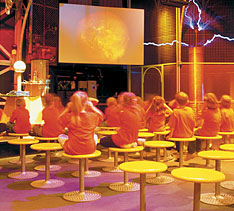 In honor of the 70th anniversary of informal science in Pittsburgh, the Science Center is bringing Zeiss out of storage to be the centerpiece of a new, permanent, interactive astronomy exhibit that will open this spring on the Science Center’s main floor. While Zeiss can no longer work its magic, the public will still be able to marvel at this analogue masterpiece. In honor of the 70th anniversary of informal science in Pittsburgh, the Science Center is bringing Zeiss out of storage to be the centerpiece of a new, permanent, interactive astronomy exhibit that will open this spring on the Science Center’s main floor. While Zeiss can no longer work its magic, the public will still be able to marvel at this analogue masterpiece.The Zeiss was retired in 1994, three years after the Buhl became Carnegie Science Center, joining the Carnegie Museums family as a sleek, modern museum of science and technology along the North Shore of the Ohio River. (The old Buhl building is now part of the Children’s Museum of Pittsburgh.) Located on the second floor of Carnegie Science Center, the new Henry Buhl, Jr. Planetarium and Observatory employed projection technology far ahead of its predecessor. But in the 21st century, technology changes seem to occur at the speed of light, and a little more than a decade after the Science Center opened, a new projection technology had been unveiled at a handful of planetariums worldwide. Thanks once again to the Buhl Foundation, in 2007 the Science Center was able to stay ahead of the curve when it announced the evolution of its planetarium technology to the DigitalSky system. Now dubbed the Buhl Digital Dome, the planetarium boasts an eight-channel, full-dome video projection system controlled by a bank of computers that stands six-feet-tall. Projecting 16 million pixels per frame, 60 frames per second, in surround sound, the new dome experience is a rarity, today employed at fewer than 10 percent of planetariums worldwide. Another perk of the new system: regular downloads of fresh satellite images compliments of NASA. “It feels like you’re immersed in a scene from space,” says James Hughes, production coordinator at the planetarium. “Whether you’re on the surface of a planet or flying through a supernova —we can show you the entire mapped universe.” Still, there’s one constant between the old and the new, says Dan Malerbo, the planetarium’s education coordinator, who is one of more than a dozen Science Center employees who began their career at the Buhl. “The show people still want to see is a basic star ID show—that much hasn’t changed,” Malerbo notes. “It’s a basic interest for all of us, to know what’s up in the sky. They’re the same stars that your grandfather saw when he looked up 50 years ago, and the same stars his parents saw.” A hub, evolvingThe Science Center still boasts such Buhl mainstays as the Miniature Railroad & Village®, a holiday tradition for many Pittsburghers, and the Tesla Coil, which continues to wow children with its lightning-like electrical sparks. Most importantly, it still serves as a hub of science-related activity —albeit on a much larger scale—like the old Buhl, whose marble corridors often buzzed with model rocket clubs, amateur astronomy groups, and lapidary society (gem lovers) gatherings.Today, the annual Science Center-sponsored science fair, the Pittsburgh Regional Science & Engineering Fair, is on record as being the third oldest science fair in the country, and after undergoing a renaissance a few years ago, it now entices an average of 1,000 middle and high school students a year to test their scientific mettle. Other programs including SciTech Days, ChemFest, Engineer the Future, Space Out! weekends, and the Girls, Math & Science Partnership, a math and science program targeted specifically to middle school girls, spark the imaginations of thousands more young people of all ages throughout the year—kids who just might make a career of science and technology tomorrow thanks to their experiences today. At the very least, says Ron Baillie, their interest in the way the world works and the way humans work within it will have been piqued—and that’s exactly the point. “Being a place that makes a serious impact on workforce development is where this industry is headed,” Baillie says. “We always saw ourselves as providing classes and camps for kids. But we’re much more focused now on also getting real scientists rubbing elbows with kids. We’re trying to get young people to keep math, science, and technology on their radar.” While maintaining and expanding on many of the old Buhl’s traditions, the Science Center has also expanded the notion of what an institute of popular science can and should be. Mission Discovery, a year-round science and art studio for middle school youth and their families, gives youngsters a chance to spend after-school hours and part of their summers in a stimulating and safe environment. Operated in partnership with The Hill House Association in Pittsburgh’s Hill District, with input from educators at all four Carnegie Museums, Mission Discovery was a key factor in the Science Center receiving the 2003 National Museum Service Award from the Institute of Museum and Library Services. New horizonsThe Science Center is expanding on its mission in other ways, too, by putting itself in the position of explaining the science that informs many of today’s largest public debates. Topics like global warming, embryonic stem cell research, and health care reform are all rooted in science, Baillie notes. Today’s Science Center now offers the public a space to engage in these kinds of scientific and ethical questions.“We can play that role of the town square for science,” Baillie says. “When there’s a controversial science topic, like embryonic stem cells, we can ask, ‘What’s the science involved?’ When we’re looking at a subject that is complex, where you can have different perspectives, we’re a catalyst for public dialogue.” As an example, Baillie points to the Science Center’s new exhibit on tissue engineering, where the potential use of embryonic stem cells in the production of new organ tissues points to ethical questions. “There’s no advocacy of any kind in that exhibit, but there’s a lot of science in it,” Baillie says. “You can go away from the exhibit and make your own decisions. What’s important is that people understand the science behind the issue. That’s a role that 20 years ago we probably wouldn’t have taken on.” As it continues to evolve, the Science Center aims to stay true to its original mission—to be “a voice for science” and to take its message to as many people as possible. The people, then, will do the rest. Baillie uses the example of one former wide-eyed Buhl attendee Mike Fincke, the Pittsburgh-born astronaut. “It was sitting in the planetarium that got Mike totally inspired by the universe,” Baillie says. “For Mike, it wasn’t so much what he learned at the Buhl that was important. It was the inspiration, the ‘wow,’ the amazement of wanting to think about the universe and wanting to discover it.” For that reason, the Science Center will continue to point the way—one star at a time. |
|
Also in this issue:
The Art of Daily Life · Welcome · Clearing a New Path · Directors' Note · NewsWorthy · Face Time: Lynn Zelevansky · Field Trip: For the Birds · Artistic License: Break-Out Performance · About Town: Social Science · Science & Nature: The Lord of the Flies · Big Picture
 |
Copyright © 2017 CARNEGIE Magazine. All rights reserved. |
